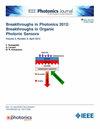LiRF:支持泛在射频信号的光基无线通信
IF 2.1
4区 工程技术
Q3 ENGINEERING, ELECTRICAL & ELECTRONIC
引用次数: 0
摘要
随着物联网(IoT)的日益普及,无线连接设备激增。在此背景下,可见光通信(VLC)因其超宽且无需许可证的频率资源而备受关注。然而,在物联网中使用可见光通信的一个关键问题在于,它无法与无处不在的基于射频(RF)的无线网络顺利合作。射频信号可以使用双工技术,用一根天线发射和接收双向信号。相比之下,VLC 的发光二极管 (LED) 和 PIN 二极管不能在双工模式下工作,这给建立两个单向 VLC 链接带来了挑战。为了解决 VLC 与射频之间的不匹配问题,我们提出了一种名为 LiRF 的光基射频收发器设计,能够通过 VLC 为物联网设备顺利传输射频信号。为了验证其可行性,我们首先在 5 GHz 频道上使用 802.11ax (WiFi-6) 网络接口卡(NIC)构建了一个原型。实验结果表明,LiRF 与 802.11bb 标准兼容,使用 200 MHz 超发光二极管-PIN(SLD-PIN)收发器可支持 750 Mbps 的 TCP/IP 数据流,使用 180 MHz LED-PIN 收发器可支持 600 Mbps 的 TCP/IP 数据流。据我们所知,这是首个利用 WiFi 网卡的实时双向 VLC 系统,能够在不改变射频设计的情况下为单个空间流实现接近 Gbps 的数据传输速率。LiRF 为将 VLC 无缝集成到即将到来的物联网网络、支持虚拟现实和增强现实等高速、低延迟应用铺平了道路。本文章由计算机程序翻译,如有差异,请以英文原文为准。
LiRF: Light-Based Wireless Communications Supporting Ubiquitous Radio Frequency Signals
As the Internet of Things (IoT) becomes increasingly prevalent, there is a surge in wireless-connected devices. In this context, one technique that has garnered significant attention is visible light communication (VLC) due to its ultra-wide and license-free frequency resource. However, a critical issue in utilizing VLC in IoT lies in its lack of smooth cooperation with ubiquitous radio frequency (RF)-based wireless networks. RF signals can use duplex techniques to transmit and receive bidirectional signals with one antenna. In contrast, VLC's light-emitting diodes (LEDs) and PIN diodes cannot operate in duplex mode, posing challenges in establishing two unidirectional VLC links. To address the mismatch between VLC and RF, we propose a light-based RF transceiver design called LiRF, capable of smooth transmission of RF signals through VLC for IoT devices. To verify its feasibility, we first build a prototype using 802.11ax (WiFi-6) network interface cards (NICs) in the 5 GHz channel. Experimental results show that LiRF is compatible with the 802.11bb standard, supporting TCP/IP data streams at 750 Mbps with a 200 MHz Superluminescent Diode-PIN (SLD-PIN) transceiver and at 600 Mbps with a 180 MHz LED-PIN transceiver. To the best of our knowledge, this is the first real-time bidirectional VLC system utilizing WiFi NICs capable of achieving near-Gbps data rates for a single spatial stream without altering the RF designs. LiRF paves the way for seamlessly integrating VLC into upcoming IoT networks, supporting high-speed, low-latency applications like Virtual Reality and Augmented Reality.
求助全文
通过发布文献求助,成功后即可免费获取论文全文。
去求助
来源期刊

IEEE Photonics Journal
ENGINEERING, ELECTRICAL & ELECTRONIC-OPTICS
CiteScore
4.50
自引率
8.30%
发文量
489
审稿时长
1.4 months
期刊介绍:
Breakthroughs in the generation of light and in its control and utilization have given rise to the field of Photonics, a rapidly expanding area of science and technology with major technological and economic impact. Photonics integrates quantum electronics and optics to accelerate progress in the generation of novel photon sources and in their utilization in emerging applications at the micro and nano scales spanning from the far-infrared/THz to the x-ray region of the electromagnetic spectrum. IEEE Photonics Journal is an online-only journal dedicated to the rapid disclosure of top-quality peer-reviewed research at the forefront of all areas of photonics. Contributions addressing issues ranging from fundamental understanding to emerging technologies and applications are within the scope of the Journal. The Journal includes topics in: Photon sources from far infrared to X-rays, Photonics materials and engineered photonic structures, Integrated optics and optoelectronic, Ultrafast, attosecond, high field and short wavelength photonics, Biophotonics, including DNA photonics, Nanophotonics, Magnetophotonics, Fundamentals of light propagation and interaction; nonlinear effects, Optical data storage, Fiber optics and optical communications devices, systems, and technologies, Micro Opto Electro Mechanical Systems (MOEMS), Microwave photonics, Optical Sensors.
 求助内容:
求助内容: 应助结果提醒方式:
应助结果提醒方式:


